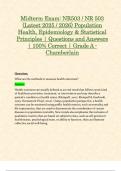Midterm Exam: NR503 / NR 503
(Latest ) Population
Health, Epidemiology & Statistical
Principles | Questions and Answers
| 100% Correct | Grade A -
Chamberlain
Question:
What are the methods to measure health outcomes?
Answer:
Health outcomes are usually defined as an end result that follows some kind
of healthcare provision, treatment, or intervention and may describe a
patient's condition or health status (Kleinpell, 2007; Kleinpell & Gawlinski,
2005; Oermann & Floyd, 2002). Using a population perspective, a health
outcome can be measured using public health metrics, such as mortality and
life expectancies, that are used to demonstrate the contribution of certain
diseases to population mortality. New trends also emphasize the inclusion of
qualitative metrics that are based on subjective data, such as self-perceived
health status, psychological state, or ability to function, that can illustrate
collective social well-being.
,Question:
What are the elements of the action model?
Answer:
Assessment, Monitoring, Evaluation, and Dissemination
Question:
Period Prevalence Rate
Answer:
Measures the number of cases of disease during a specific period of time and
is a measure of burden
Question:
Positive Predictive Value (PPV)
Answer:
A measure of the probability of a positive test result when the disease is
present
Question:
Epidemiological Triangle
Answer:
1. The relationship between risk factors and disease is complex. Research
studies may describe a relationship between a risk factor and disease, but how
do we know this relationship is causal? An understanding of causation is
, important if APRNs want to effectively impact the health of populations. The
epidemiological triangle is a model that has historically been used to explain
causation. The model consists of three interactive factors: the causative agent
(those factors for which presence or absence cause disease—biologic,
chemical, physical, nutritional), a susceptible host (such things as age,
gender, race, immune status, genetics), and the environment (including such
diverse elements as water, food, neighborhood, pollution). A change in the
agent, host, and environmental balance can lead to disease (Harkness, 1995).
The underlying assumptions of this model are that causative factors can be
both intrinsic and extrinsic to the host and that the cause of disease is related
to interaction among these three factors. This model initially was developed
to explain the transmission of infectious diseases and was particularly useful
when the focus of epidemiology was on acute diseases. It is less helpful for
understanding and explaining the more complicated processes associated
with chronic disease. With the rise of chronic diseases as the primary cause of
morbidity and mortality, a model that recognizes multiple causative factors
was needed to better understand this complex interaction.
Question:
Confounding Variables
Answer:
Occurs when it appears that a true association exists between an exposure and
an outcome, but in reality, this association is confounded by another variable
or exposure.




